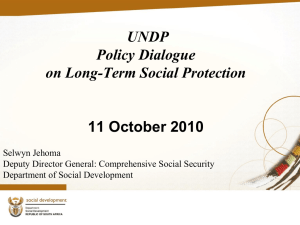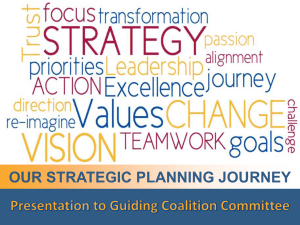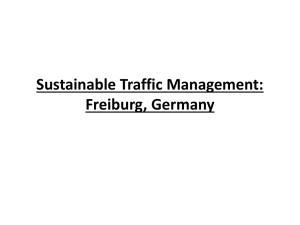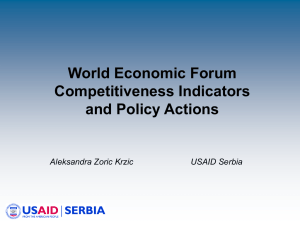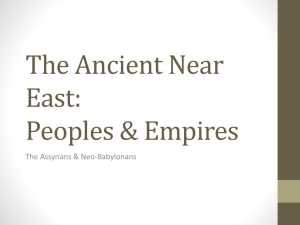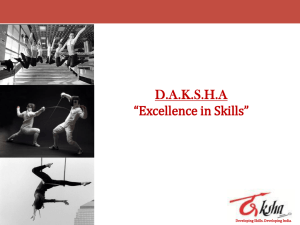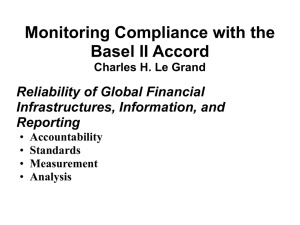Conflict and the Environment - Center for International Studies
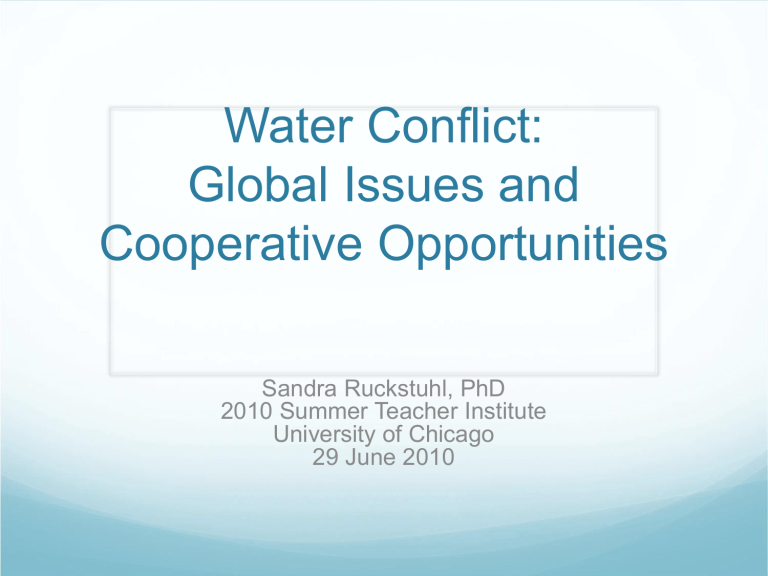
Water Conflict:
Global Issues and
Cooperative Opportunities
Sandra Ruckstuhl, PhD
2010 Summer Teacher Institute
University of Chicago
29 June 2010
Structure of Presentation
CONF 695 Water and Conflict
Conflict Analysis and Resolution
Environmental Conflict
Water Conflict
Water and Dennis Sandole’s Three Pillar Model
Cases
Conclusion
CONF 695: Water and Conflict
Integrate conflict theory, water concepts, and case literature
Case study approach to highlight social and environmental challenges and perspectives at different levels
Critical thinking and internal debate
Guest speakers from the field
Student presentations – on cases, on research, on policy proposals
Conflict Analysis and Resolution
Principles
Conflict studies = analysis and resolution
Interdisciplinary - social psychology, international re, development studies, cultural studies
Promotes critical thinking about social relationships, needs, aspirations and power between individuals and groups
Conflict is not necessarily bad (innovation)
Violence is a negative manifestation of conflict
Cooperation is an inherent opportunity in everything
Conflict Analysis and Resolution
Integrative Practice
PEACEMAKING
PEACE-
BUILDING
PREVENTIVE
ACTION
Conflict Analysis and Resolution
Christopher Mitchell’s SPITCEROW Model
S = Sources
P = Parties
I = Issues and interests
T = Tactics
C = Changes
E = Enlargement
R = Roles
O = Outcomes
W = Winner
Conflict Analysis and Resolution
Dennis Sandole’s Three Pillar Model
PILLAR 2
Conflict Conditions
PILLAR 1
Conflict Sources
Individual level
Societal level
International level
Global/ecological level
Parties (violent)
Issues
Objectives
Means
Conflict-handling orientations
Conflict environment
PILLAR 3
Conflict Resolution
Prevention
Management
Settlement
Resolution
Transformation
Environmental Conflict
What is it?
“Environmental conflict” boils down to conflict (or “disputes”) over environmental resources.
Analysis = What is the nature of these disputes?
Resolution = How can we address them?
Environmental Conflict
What are the “resources”?
Conflict over non-renewable (finite) resources
Minerals (diamonds, oil, coltan)
Land (property rights)
Conflict over renewable resources
Forests and timber
Air
Water
Environmental Conflict
What are the dynamics?
Environmental Conflict
What are the dynamics?
The environment
(water resources included) is neither a necessary nor sufficient cause of violent conflict
Environmental Conflict
What are the dynamics?
RELATIVE SCARCITY + POOR INSTITUTIONAL CAPACITY
= POTENTIAL CONFLICT
Supply-, demand-, structurally driven scarcity leads to conflict (Homer-Dixon 1999)
Demographic stress (environment + population) leads to state failure/exploitation (Kahl 2002)
Differential power and differential impacts of environmental degradation (Peluso and Watts 2001)
BUT if we think critically and creatively human ingenuity can overcome…
Water Conflict
shared water resources.
could change too.
Water Conflict
Popular coverage of and rhetoric around international “water wars”
Indirect role in intrastate , rather than interstate, violent conflict
Internal fragility associated with inequity of water scarcity problems
Problems with quality and quantity
Water Conflict
Environmental change (including global warming) means more water in some areas, less water in others, and pollution worldwide
Environmental change can cause social stress and lead to conflict if institutions cannot adjust to those changes in a productive way
Water Conflict
A source of destruction, poverty & dispute
• Drought
• Flood & inundation
• Landslide
• Desertification
• Contamination
•
Epidemic & disease
• Dispute, even conflict
A source of production, growth & cooperation
• Healthy people
• Healthy ecosystems
• Food production
• Energy production
• Navigation
•
Cultural Value
• Cooperation
Conflict Analysis and Resolution
Dennis Sandole’s Three Pillar Model
PILLAR 2
Conflict Conditions
PILLAR 1
Conflict Sources
Individual level
Societal level
International level
Global/ecological level
Parties (violent)
Issues
Objectives
Means
Conflict-handling orientations
Conflict environment
PILLAR 3
Conflict Resolution
Prevention
Management
Settlement
Resolution
Transformation
Three Pillar Model
Conflict Sources: Parties
There are many different users of water:
Water for people (supply and sanitation)
Water for environment (ecosystems)
Water for food (irrigation)
Water for energy (hydropower)
Water for other purposes
(e.g., culture or religion)
They have different, sometimes competing needs.
Three Pillar Model
Conflict Sources: Parties
upstream vs. downstream
urban vs. rural
rich vs. poor
haves vs. have-nots
Three Pillar Model
Conflict Sources: Parties
Water resources (e.g., rivers, aquifers, lakes) cross different kinds of jurisdictional lines
Interstate
Intrastate
Three Pillar Model
Conflict Sources: Issues
Relative scarcity + institutional capacity deficiencies = conflict
Ownership
Who has the right to it?
Consumption
How should it be used?
Distribution
Who has access and who does not?
Management
How should it be governed?
Three Pillar Model
Conflict Sources: Issues
Category
Renewable natural resource changes
Other physical changes
Relational changes
Type
Quality
Quantity
Temporal
Variability
Demographic
Infrastructure
Behavioral
Parties (individuals and groups)
Institutions
Power and influence
Eco-economic changes
Conflict tactics
Value of and relationship to the resources
Three Pillar Model
Conflict Sources: Issues
Three Pillar Model
Conflict Sources: Issues
Three Pillar Model
Conflict Sources: Issues
Direct/indirect control over resources = power
Control over supply (domestic and industry)
Control over food production (domestic and export)
Control over environment (drought and flood)
Control over health issues (diseases)
Control over energy production (hydropower)
Three Pillar Model
Conflict Conditions: Individual/Societal
Water Scarcity 2025
Three Pillar Model
Conflict Conditions: Individual/Societal
Three Pillar Model
Conflict Conditions: Societal/International
Projected Population
Developing & Transition Countries (DTC) and OECD
Mega cities
Rapid urban growth in secondary cities & towns
Still many in fragile rural areas
Three Pillar Model
Conflict Conditions: International
More than 260 river basins with more than 2 countries…
Three Pillar Model
Conflict Conditions: International
Tensions longstanding and growing with demand…
Three Pillar Model
Conflict Conditions
Physical Effects of Climate Change
Increased variability, availability and access to resources
Changes in precipitation
Glacial melt
Reduced quality of land (erosion, contamination)
Increased desertification
Changes to crop seasons
Changes in biodiversity
Rising sea levels
Flooding coastal areas, including urban habitats and farmland
Disruption of aquatic habitats and fish populations
Natural disasters and extreme weather events (i.e. hurricanes, flash floods, droughts, landslides, wild fires, spread of disease and pestilence)
Three Pillar Model
Conflict Conditions
Social Impacts of Climate Change
Loss of livelihoods
Economic shocks and instability
Food shortages and food insecurity
Human health impacts (e.g. disease)
Food insecurity
Trade relations
Migration
Political instability and state fragility
Spillover effects impacting neighboring areas
Inequitable impacts and social tensions
Three Pillar Model
Conflict Resolution
Conflict prevention (early intervention/diplomacy)
Conflict management (security operations and peacekeeping)
Conflict settlement (coercive peacemaking)
Conflict resolution (non-coercive peacemaking)
Conflict transformation (social cohesion, resilience, capacity)
Three Pillar Model
Conflict Resolution
Building capacity to deal with conflict:
Organizations
(e.g., policy and official administrative structures) and
Institutions
(e.g., norms, values, perceptions, behaviors, knowledge)
Three Pillar Model
Conflict Resolution
Environmental Peacebuilding
Capitalizes on ecological interdependencies to promote social, economic, and political relationships through joint environmental management and benefit sharing
Opportunities both for prevention and transformation are everywhere…
Cases
Nile River Basin
Cases
The Sahel Region
Cases
Yemen
Cases
Israel and the Palestinian Territories
Cases
The Dead Sea
Cases
Indus River Basin
